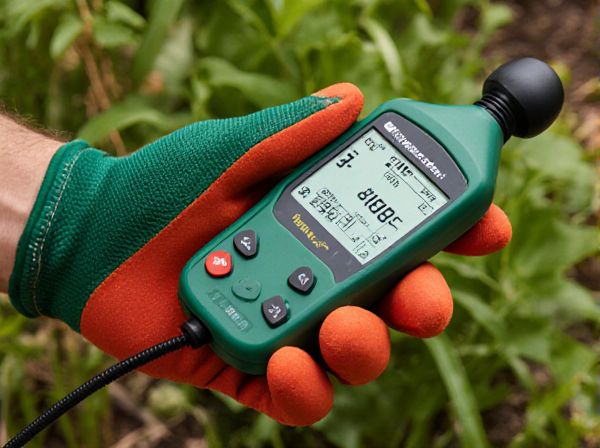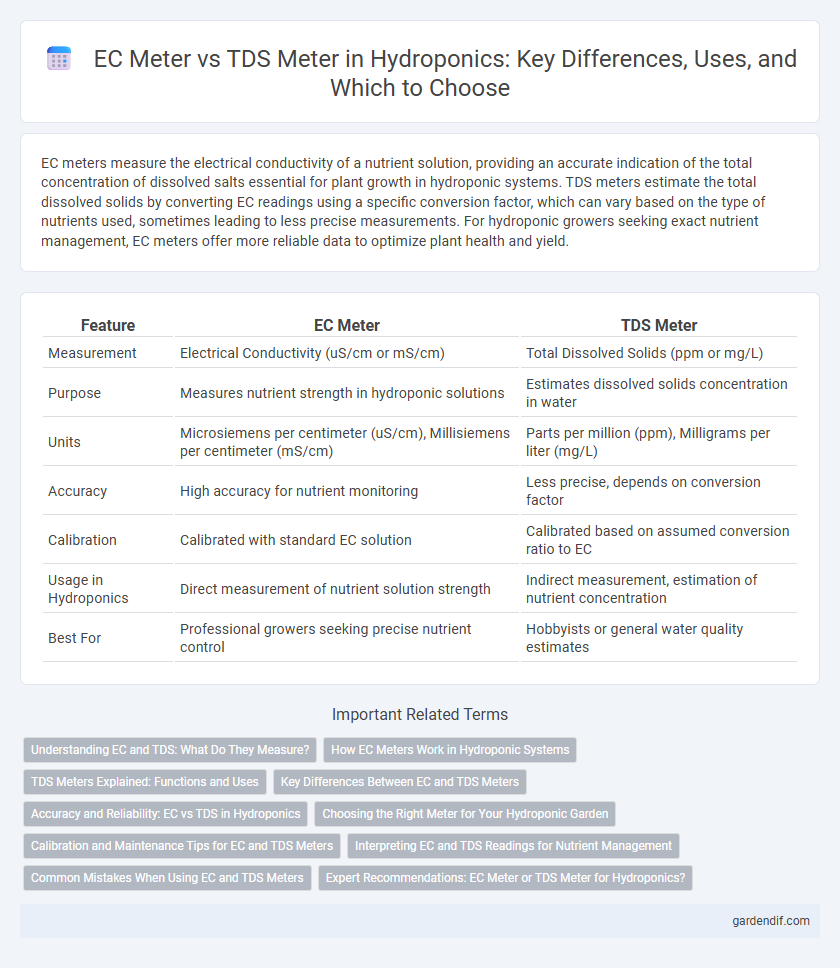
EC Meter vs TDS Meter Illustration
EC meters measure the electrical conductivity of a nutrient solution, providing an accurate indication of the total concentration of dissolved salts essential for plant growth in hydroponic systems. TDS meters estimate the total dissolved solids by converting EC readings using a specific conversion factor, which can vary based on the type of nutrients used, sometimes leading to less precise measurements. For hydroponic growers seeking exact nutrient management, EC meters offer more reliable data to optimize plant health and yield.
Table of Comparison
| Feature | EC Meter | TDS Meter |
|---|---|---|
| Measurement | Electrical Conductivity (uS/cm or mS/cm) | Total Dissolved Solids (ppm or mg/L) |
| Purpose | Measures nutrient strength in hydroponic solutions | Estimates dissolved solids concentration in water |
| Units | Microsiemens per centimeter (uS/cm), Millisiemens per centimeter (mS/cm) | Parts per million (ppm), Milligrams per liter (mg/L) |
| Accuracy | High accuracy for nutrient monitoring | Less precise, depends on conversion factor |
| Calibration | Calibrated with standard EC solution | Calibrated based on assumed conversion ratio to EC |
| Usage in Hydroponics | Direct measurement of nutrient solution strength | Indirect measurement, estimation of nutrient concentration |
| Best For | Professional growers seeking precise nutrient control | Hobbyists or general water quality estimates |
Understanding EC and TDS: What Do They Measure?
EC meters measure the electrical conductivity of a nutrient solution, reflecting the concentration of dissolved salts that directly affect plant nutrient uptake in hydroponic systems. TDS meters estimate total dissolved solids by converting electrical conductivity readings into a general measure of all dissolved substances, but they do not distinguish between specific ions or nutrient types. Understanding that EC provides precise ion concentration values while TDS offers an approximate overall dissolved solids level helps growers accurately manage nutrient strength for optimal hydroponic plant growth.
How EC Meters Work in Hydroponic Systems
EC meters measure the electrical conductivity of the nutrient solution by detecting the ability of dissolved salts to conduct electrical current, providing precise insight into nutrient concentration levels essential for hydroponic plant growth. These meters help maintain optimal nutrient balance by delivering real-time data that reflects the concentration of ions such as nitrates, phosphates, and potassium critical to plant health. Accurate EC readings enable growers to adjust nutrient solutions effectively, preventing deficiencies or toxicities that could compromise crop yield and quality in hydroponic systems.
TDS Meters Explained: Functions and Uses
TDS meters measure total dissolved solids in hydroponic nutrient solutions by detecting the electrical conductivity indirectly, providing growers with precise data on nutrient concentration. These devices help maintain optimal nutrient levels by quantifying the combined concentration of dissolved salts, minerals, and ions essential for plant growth. Regular use of TDS meters enables hydroponic cultivators to prevent nutrient deficiencies or toxicities, ensuring healthier crops and improved yields.
Key Differences Between EC and TDS Meters
EC meters measure the electrical conductivity of a nutrient solution to indicate its ion concentration, while TDS meters estimate total dissolved solids by converting conductivity values using a specific factor. EC meters provide more precise readings of nutrient strength essential for hydroponic systems, whereas TDS meters offer approximate data that can vary based on water composition. Understanding the key difference that EC meters directly assess ion concentration improves accuracy in managing nutrient delivery for optimal plant growth in hydroponics.
Accuracy and Reliability: EC vs TDS in Hydroponics
EC meters measure the electrical conductivity of nutrient solutions, providing precise and direct readings of ion concentration essential for accurate nutrient management in hydroponics. TDS meters estimate the total dissolved solids based on conductivity but often rely on a conversion factor that can cause less reliability and variability in results depending on solution composition. For hydroponic growers seeking consistent accuracy in nutrient monitoring, EC meters offer superior reliability compared to TDS meters, ensuring optimal plant growth and yield.
Choosing the Right Meter for Your Hydroponic Garden
Choosing the right meter for your hydroponic garden depends on whether you want to measure the electrical conductivity (EC) or total dissolved solids (TDS) in your nutrient solution. EC meters provide a direct measurement of the solution's conductivity, indicating the nutrient concentration and helping optimize plant health. TDS meters convert EC readings into parts per million (ppm), which can vary based on the conversion factor, so for precise nutrient management, EC meters are generally preferred in hydroponic systems.
Calibration and Maintenance Tips for EC and TDS Meters
Accurate calibration of EC meters is essential for precise nutrient management in hydroponic systems, typically involving the use of standard buffer solutions with known electrical conductivity values. TDS meters require calibration with appropriate standard solutions to ensure reliable measurement of dissolved solids, as variations in water composition can impact readings. Regular maintenance includes cleaning probe sensors with distilled water, avoiding exposure to harsh chemicals, and periodic recalibration to maintain meter accuracy and extend device lifespan.
Interpreting EC and TDS Readings for Nutrient Management
EC meters measure electrical conductivity in hydroponic solutions, providing direct insight into nutrient ion concentration essential for precise nutrient management. TDS meters estimate the total dissolved solids by converting EC values, giving a generalized indication of nutrient levels but potentially less accuracy due to calibration variances. Understanding the correlation between EC and TDS readings enables growers to adjust nutrient formulations effectively, optimizing plant growth and preventing nutrient imbalances.
Common Mistakes When Using EC and TDS Meters
Common mistakes when using EC and TDS meters include failing to calibrate the devices regularly, leading to inaccurate readings that affect nutrient management in hydroponic systems. Another frequent error is neglecting to clean the probes properly, causing buildup that distorts conductivity and total dissolved solids measurements. Users also often confuse EC values with TDS, ignoring that EC measures electrical conductivity while TDS estimates the concentration of dissolved solids, resulting in improper nutrient adjustments.
Expert Recommendations: EC Meter or TDS Meter for Hydroponics?
Experts recommend using an EC meter for hydroponics because it directly measures the electrical conductivity of the nutrient solution, providing accurate insights into nutrient ion concentration essential for optimal plant growth. While TDS meters estimate total dissolved solids by converting conductivity to ppm, they can vary based on the conversion factor, leading to potential inaccuracies in nutrient management. Precise control of EC levels ensures balanced nutrient delivery, making EC meters the preferred tool for hydroponic systems.
EC Meter vs TDS Meter Infographic

 gardendif.com
gardendif.com